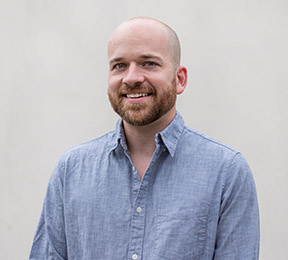Alumnus Profile
Physics and Architecture: Finding the Balance

Jeff Badger has a sincere appreciation for the role of synthesis and balance when it comes to creativity—how to start with well-understood concepts and draw on inspiration to design something functional. He spent some time from his lunch break to explain how his career has evolved along those lines and took him to Santa Monica, California, where he works as a designer for Moore Ruble Yudell Architects & Planners.
Originally from Franklin, Tennessee, Badger came to UT as a physics major and graduated with a bachelor’s degree in 2008. He was drawn to the Knoxville campus for multiple reasons: he was a Tennessee football fan growing up, UT was close to home, and he knew the physics department was a strong one. That last bit was especially important to someone who, like many science students, has always been intrigued by getting to the bottom of things.
"As a kid I always liked how you could explain how the world works with physics," he said. "Kind of the idea that if you drill down far enough into the experiments and the math you could figure out how and why anything works the way it does."
For Badger, the more tangible aspects of physics were the most interesting: particularly the lasers, mirrors and fiber optics in Professor Marianne Breinig’s optics course, which he cites as his favorite class. Yet he was also someone who enjoyed drawing floor plans as a kid, so he found a way to bring those areas together when he decided to pursue architecture after finishing a degree in physics.
"It was a mid-stream decision," he said. "I think as I got further and further into physics and math courses I realized that I enjoyed the real-world aspect of it a little bit more, and I missed some of the drawing and the design that I used to enjoy, so architecture seemed like a good synthesis of those things."
Badger went on to the University of Cincinnati and completed a master’s in architecture in 2012. His physics degree proved helpful in gaining admission to the program.
"It gave me a unique background compared to a lot of other people going into architecture," he said.
Badger interned with Moore Ruble Yudell and ultimately went to work with the firm, where his physics education is still paying dividends.
"An important part of architecture is that synthesis of design and engineering," he explained. "I’m not a structural or electrical engineer but my physics background helps me understand the underlying concepts better; it makes it easier to integrate all these different building systems together. I can inform my designs from the very beginning with an understanding of those concepts before the engineer is even involved. And the more we can integrate those things like lighting, acoustics, and building systems early on, the more successful the design is going to be."
His firm has a myriad of clients with work ranging from single family residential projects to academic lab buildings, courthouses, embassies, etc. As a designer, his responsibilities may start with researching local building codes and investigating the building site and carry through to inspecting the actual construction as a building goes up.
Badger’s enthusiasm for building extends to his free time, where his hobbies include landscape and architectural photography, as well as woodworking. While he logged plenty of hours in the Nielsen Physics Building as an undergraduate, he also spent a great deal of time in the Art and Architecture Building, where he learned or enhanced his skills in drawing, woodworking, and metal fabrication. He emphasized that courses like these were a good idea for any physics major and it was never too soon to start.
"I would recommend art classes to any of the current physics students as a good balance to their math and physics coursework," he said.
He also had some advice for students who may be on the fence about majoring in physics out of concern that it might limit their options later on.
"A physics education is a great foundation for a lot of different careers," he said. "Personally, looking for jobs in architecture, I’ve never had anybody look at my resume and say a physics degree was a negative. It’s almost always an unexpected positive."